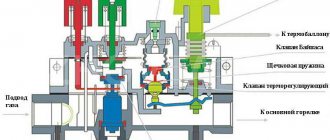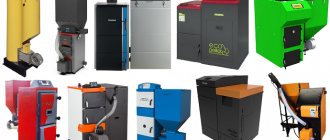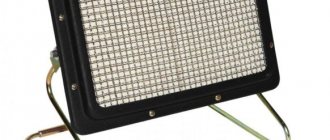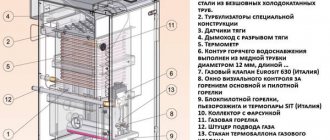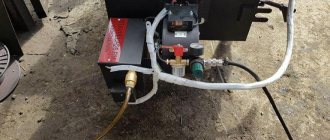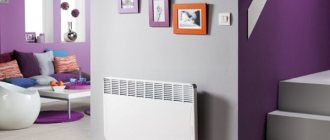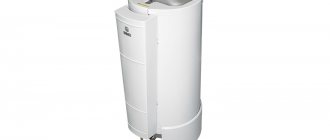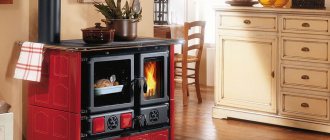In recent years, Russian manufacturers of heating equipment have achieved considerable success.
One of the devices that has become popular is, without a doubt, the Conord gas boiler: reviews of this equipment in the vast expanses of the Runet are quite common.
What exactly users write and what types of boilers this manufacturer offers will be discussed in our article.
About company
The production facilities of the Russian brand Conord are located in Rostov-on-Don. Gas heaters have been produced here since the seventies of the twentieth century. Today it is a leading Russian manufacturer, the quality of its products is based on large-scale modernization of production. Instead of old machines, European lines were launched - Swiss and Italian. The cost of manufactured heaters is much lower than European ones - in the range of 15-50,000 rubles.
CONORD is not just a name consonant with the name of a large eagle, it is an abbreviation. It stands for: Heating boilers of non-standardized equipment Rostov-on-Don. The first heating boiler produced by the company is DON-16.
Conord gas boiler malfunction:
The table below shows a common list of typical malfunctions, their causes and solutions:
- Conord gas boiler automatic does not work;
- Conord gas boiler does not ignite;
- Conord gas boiler does not ignite; igniter no gas supply;
- Conord gas boiler does not reach temperature;
- And many others.
Part 1
Part 2
New features are shown below, watch the video review:
Advantages
After reading reviews about the products of the Rostov enterprise, it is easy to understand that they are in high demand. The Russian consumer is attracted to Conrod products by:
- Cost - prices for Russian products are much lower than for European ones. Sometimes the difference is 50%. The cheapest 8 kW models, used for heating a private home, cost only 15,000 rubles.
- Long warranty. The manufacturer guarantees uninterrupted operation for fifteen years.
- Does not depend on electricity. A blackout, especially in winter, due to lack of electricity, is almost a disaster. Therefore, for volatile equipment it is necessary to install backup power - a generator or battery. There are no such problems with Conord.
- Easy to use. The abundance of functions, electronics and automation from other brands often causes unnecessary trouble.
- Quiet operation.
- High quality build.
- Good technical characteristics: Rostov boilers are practically not inferior to foreign analogues in productivity, efficiency, and heating speed.
- High efficiency - about 90%.
Advantages of the Conord steel boiler
- Larger selection of models.
- Steel boilers are more convenient to maintain. The heat exchanger, for example, is easier to clean. Since steel does not crack from impacts, this greatly facilitates the activities associated with removing carbon deposits. Maintenance and cleaning must be carried out regularly, otherwise the Conord boiler loses its high efficiency indicators.
- Steel boilers are impact-resistant structures, so you don’t have to worry about damage during transportation.
- The maintainability of a steel Conord boiler is much better than a cast iron boiler. Possible “burnouts” are brewed on the spot, of course in the case of a minor nature.
Design Features
- Convenient adjustment. Heating is adjusted by a mechanical rotary regulator, which allows you to change the strength of the fire.
- Simple ignition - no complex automation, which in imported analogues often makes you nervous.
- Thanks to its special design, the cold-rolled steel heat exchanger is resistant to overheating, which significantly increases its service life.
- The burner is capable of operating even at the lowest gas pressure.
- Low heat loss - the body is thermally insulated.
- Dimensions are modest. Floor-standing units are always larger than wall-mounted units, but Conord’s dimensions are quite acceptable for small rooms. Stylish design - easily combined with modern interiors.
- The body is lined with steel sheets (3 mm thick): thanks to the powder coating, they are characterized by increased heat resistance.
- The burner flame is modulated automatically - the device is economical and efficient.
- A transition to another fuel is provided.
- The security system protects the device from emergency situations.
When should you choose the minimum power?
In order to make a more accurate calculation, it is necessary to contact specialists who are able to develop a professional system design, taking into account the individual characteristics of a particular building. It is important to pay attention to the minimum power rating of the unit. The smaller this value is, the more comfortable and economical the device will operate at a minimum of capabilities. This is especially true for the period of spring and autumn, or rather, in the off-season.
What are they?
If you are interested in the products of the Rostov manufacturer, you can choose a boiler from four series.
- With Italian automatic equipment SIT: KSts-G-S/ KSts-GV-S - single-circuit/double-circuit.
- With thermo-hydraulic automation: KSts-G-N/KSts-GV-N - single-circuit/double-circuit.
The manufacturer offers heating boilers with two types of heat exchangers: steel and cast iron. All gas heaters produced by the Rostov enterprise are only floor-standing. If you're interested in a wall-mounted unit (with a closed firebox), you'll have to look to a different brand.
Steel
Heaters with steel heat exchangers have the following advantages:
- Steel is more ductile compared to cast iron.
- Specific gravity is less.
- High heat dissipation.
There is one minus, but a very important one - low resistance to damage and corrosion. That is why consumers who know a lot about materials choose cast iron analogues. Manufacturers try to minimize this by using durable coatings, but they cannot provide 100% corrosion protection.
Cast iron
The main advantages of cast iron heat exchangers: high thermal conductivity and immunity to corrosion.
Minuses:
- Cast iron is less flexible and ductile than steel and is not as resistant to deformation.
- Inferior to steel in strength.
- Brittleness is the main disadvantage of cast iron. Particularly dangerous situations arise during transportation and installation, which is why installation should be entrusted to specialists. After delivering the device home, be sure to check the integrity of the cast iron heat exchanger. Even the presence of microcracks is a most dangerous situation for equipment. If they appear, the equipment will soon fail and the heat exchanger will need to be replaced.
Floor cast iron models
Conord boilers with a cast iron heat exchanger are marked according to the same scheme, only the letter combination “KCH” is written first.
A cast iron heat exchanger has almost twice the service life of a steel one (25 years versus 15) and is not afraid of corrosion.
So, if the floor structures can support its weight, this type of heat exchanger is preferable.
The buyer of a cast iron boiler should take into account an important point. Unlike steel, cast iron is brittle, so microcracks may appear in it during careless transportation.
If they are present, the service life of the heat exchanger will be significantly reduced. Also, due to its fragility, the product may burst if the temperature fluctuates sharply.
Secrets of High Performance
Modifications with thermohydraulics are non-volatile. The operating principle is based on the use of a thermostat. When the temperature reaches the declared value, the gas supply to the burner stops. This maintains the necessary heating of the coolant.
The devices are ideally adapted for harsh winters: they can stably maintain the required heating, the main thing is to correctly calculate the power. Efficiency increases due to:
- modulating burner;
- obtaining the optimal composition of the gas-air mixture;
- leaving the bulk of the heat for heating the coolant.
Description and automation
The Conord boiler is made of 3 mm thick steel and has a high efficiency of 90%. It became popular due to two serious advantages: budget cost and independence from electricity. Today, Conords are produced in two modifications - with and without the ability to prepare hot water.
Moreover, any model can be equipped with thermo-hydraulic automatics or SIT automatics. This function makes it energy independent, and the fuel supply is controlled by a thermostat. This happens as follows: when the temperature reaches a certain parameter, the gas supply is shut off; This is how comfort mode is maintained.
This equipment is designed for moderately cold or very cold winters: the main thing is to correctly calculate the required power, and the unit itself will maintain the optimal temperature.
How to decipher the symbols
For example:
- KSts-GV-12
- KSts-G-10S
"K" is for boiler. "C" - made of steel. "C" - cylindrical firebox. "G" - gas. "GW" - heats the water. The number is the maximum power.
How to choose the right performance? For 10 sq.m you need 1000 W (ceiling height 2.5 m). This formula is suitable for rooms with average heat loss.
Second group with a steel heat exchanger:
The Conord boiler with the design of a steel cylindrical heat exchanger made of cold-rolled metal is offered by the plant in single- and double-circuit versions. The service life is reduced compared to cast iron to 15 years. The designs use two automation options.
The first option: SIT automation from an Italian company known for its quality throughout the world. It is installed in the vast majority of all manufactured boilers in the European Union, such famous devices as: IMMERGAS, Fondital, Vaillant, Bosch and many others. The SIT valve allows you to guarantee a stable set temperature.
In addition, automation controls stable operation with a reduced gas pressure in the city pipeline. So the nominal value provides for operation with a pressure of 1.3 kPa, but a drop to 0.6 kPa is not a big problem and the Conord gas boiler continues to operate steadily, despite the fact that this is 46% less than required.
Single-circuit, with automatic SIT – heating only:
KSts-G-8S Heating capacity =8 kW KSts-G-10S Heating capacity =10 kW KSts-G-12S Heating capacity =12 kW KSts-G-16S Heating capacity =16 kW KSts-G-20S Heating capacity =20 kW KSts-G-25S Heating capacity =26 kW KSts-G-30S Heating capacity =30 kW KSts-G-40S Heating capacity =40 kW KSts-G-50S Heating capacity =50 kW
Single-circuit, with thermohydraulic automation
The second option is more budget-friendly, equipped with domestically developed AGU-T-M automatic equipment. AGU is an automatic gas burner device, consisting of nozzles and safety automation. The main manufacturers are Mimax and Tagonrog. ASU automation consists of:
- temperature sensor;
- igniter with thermo-bimetallic plate;
- adjusting screw with lever;
- gas valve;
- block crane;
- connecting parts.
Ignition order:
- We check the draft, move the damper, light the igniter.
- Press the gas valve and light the wick. We fix and do not release the button until the bimetallic plate heats up.
- While continuing to hold the button, follow the lever. It will creep onto the inscription “on the button”, we need to wait for the moment when it is fixed.
- Release the gas valve and set the required temperature using the control knob.
Domestic automation makes it possible to buy a Conord boiler a little cheaper. In contrast to European analogues, it has the simplest design. It is non-volatile - no power supply is required. The starting process is carried out manually by igniting with matches or a lighter. By the way, thermo-hydraulic automation type AGU-T-M is widely used in Russian gas boilers
According to customer reviews, such automation is completely unpretentious, and the Conord floor-standing boiler equipped with it is not “capricious.” In addition, it is not difficult to find spare parts on the market even far from city centers. The prices are also not satisfactory, for example, one of the frequently requested parts - a bimetallic plate - is found everywhere for no more than 100 rubles.
KSts-G-10N Heating capacity =10 kW KSts-G-12N Heating capacity =12 kW KSts-G-20N Heating capacity =20 kW KSts-G-25N Heating capacity =25 kW KSts-G-30N Heating capacity =30 kW
Double-circuit with DHW and SIT automatic control system
The Conord floor-standing gas boiler, when equipped with two circuits, copes with the task of heating buildings and at the same time is capable of preparing hot water used for household needs. The design uses the proven modulation function. Burner operation using modulation significantly increases the efficiency of hot water supply.
KSts-GV-8S Heating capacity =8 kW KSts-GV-10S Heating capacity =10 kW KSts-GV-12S Heating capacity =12 kW KSts-GV-16S Heating capacity =16 kW KSts-GV-20S Heating capacity =20 kW KSts-GV-25S Heating capacity =25 kW KSts-GV-30S Heating capacity =30 kW
Double-circuit with DHW, with thermo-hydraulic automation
KSts-GV-12N Heating capacity =12 kW KSts-GV-20N Heating capacity =20 kW KSts-GV-25N Heating capacity =25 kW KSts-GV-30N Heating capacity =30 kW
Boiler Conord decoding
- K – boiler
- C – steel material for the heat exchanger
- C – cast iron, heat exchanger material
- G – gas
- B – DHW circuit
- C – cylindrical.
How they work
The firebox is made of 3 mm steel sheets. There is a water jacket, a gas burner unit and smoke pipes with turbulators, which increase the efficiency of the device. The gas burner unit operates automatically - the power is modulated. Basalt cardboard is used for thermal insulation. There is a thermometer to visually monitor the water temperature.
If the model is 2-circuit, then the chimneys are equipped with a coil for hot water supply. The input-output of the latter is located on the rear panel of the case. The diameter of the pipes is 2 inches / 5 cm. For hot water supply - 0.5 inches or 1.5 cm. Devices with a power of 8-12 kW have a chimney with a diameter of 11.5 cm. 16 kW - 15 cm. There are modifications with and without circulation pumps .
Important! The coolant of the system is plain water; the use of antifreeze is prohibited.
Types and characteristics
Conord floor-standing devices are available with different powers - from 8 to 30 kW. They come with one circuit: these are models KSts-G-8 and KSts-G-10, KSts-G-12 and KSts-G-16, KSts-G-20 and KSts-G-25, as well as KSts-G- thirty; and with two circuits: KSts-GV-10 and KSts-GV-12, KSts-GV-16 and KSts-GV-20, KSts-GV-25 and KSts-GV-30.
Each letter in this case will have its own meaning:
- “K” is the name of the device – “Boiler”.
- “C” is the type of material from which the boiler is made. In this particular case it is steel.
- “C” – the firebox is released in the form of a cylinder.
- “G” - without other letters nearby will mean that in front of you is a gas unit.
- The letters “DHW” will show you that in a particular case there is a product with a DHW function in front of you.
- The numbers in this name indicate the level of the maximum power indicator of the device. When selecting these parameters, you need to take 1 kW to heat a room of 10 m2 with a wall height of no more than 2.5 m.
Thus, the KSts-GV-12 device is a steel boiler with a cylinder firebox, having a hot water supply function and a maximum power of 12 kW. Products with one circuit are selected only for heating a home with an area of 30 to 300 m2. Double-circuit devices from Conord can be used for heating and for producing heated water.
In the line of this popular brand there are almost no options for models for walls; for this reason, for their home heating system, ordinary people buy floor-standing boilers, which sometimes have a number of additional features. Floor products are produced in 4 popular series. The plant produces all units from high quality steel. To improve the durability of the boiler, a special powder layer is applied to its body, which will protect the device from exposure to fairly high temperatures and severe loads.
KSC-G-S
In this series you can easily find an excellent device with one circuit, which will also be equipped with a fairly convenient regulator for fuel supply. Imported automation, which is necessary to control the entire operation of the product, guarantees its complete safety. Devices from this series can be adapted to heat buildings with areas from 80 m2 to 300 m2, but you must choose the right boiler according to its power.
How to maintain your warranty
In order not to be denied warranty obligations, you should not undertake installation and adjustment work. Connection, configuration, and first start-up are carried out by service center specialists. They also make a record of the work done in the device passport. Preventative maintenance should be carried out annually - this is also noted in the technical passport. Failure to maintain such records will void the warranty.
The instructions and connection diagram are provided for reference. Their presence in the package does not mean that the owner of the equipment can connect it himself.
User manual
To avoid loss of warranty, the manufacturer does not recommend installing or repairing boilers yourself. This can only be done by specialists who have special qualifications for working with gas equipment. Service workers will be able to properly install and configure the boiler, turn it on and test it, and check its performance. After installation, they must make an entry in the passport, after which preventative maintenance of the boiler is carried out once a year. After each preventive maintenance, a corresponding note is made in the technical passport. If there are no entries in the document, the manufacturer has the right to void the warranty.
Installation nuances
Reviews from owners confirm that Conord may go out. Provoking factors:
- The burner is dirty. Before turning on the device, you should clean the nozzles with a brush or vacuum cleaner.
- There is not enough oxygen to start the burner. The air nozzles should be cleaned and the room ventilated.
- Thermostat contacts have oxidized. Cleaning needs to be done.
- Automation sensors are broken.
If the coolant cools down too much, you need to switch the thermostat to maximum or increase the flow of gas to the burner, if the instructions allow such an action.
Features of summer use
In summer it is necessary to turn off the heating circuit. To do this, turn off the tap at the coolant inlet. When one pilot burner is running, the water will heat up to 60 °C in 60 minutes. If water is not consumed, it will retain heat for about two hours - it can be used for domestic needs. When the device heats up and there is no active consumption of water, it is turned off so that the water does not boil.
Advantages of Conord boilers:
- The manufacturer promises more heat for less money;
- Gas consumption ranges from 0.44 to 2.74 for the steel version and from 1.99 to 4.8 m3/h for the cast iron version. A significant reduction was achieved by using innovative technologies in the creation of modulation burners;
- Straight lines – laconic design;
- Cost-effectiveness is determined, among other things, by good thermal insulation;
- Efficiency from 90% in steel to 92% in cast iron;
- Two types of automation;
- Security has a multi-level basis. The draft sensor in the design of the smoke collector instantly shuts off the flow of gas in the absence of natural smoke removal. The overturning of the draft, in the event of a discharge during a strong gust of wind, will not disrupt the stable operation of the Conord boiler if this phenomenon is of a short-term nature;
- Low noise performance.
- During the warm summer period, you can use only the second circuit without using the heating circuit. That is, the boiler works like a gas water heater in summer;
- Application of multi-layer protection on the cladding: zinc coating, followed by a layer of polymer included in the paint and a film of synthetic material completes the “pie”;
- Functionality: installed in both open and closed heating systems;
- Optimal ratio of cost and quality;
- The Conord boiler has successfully passed tests in accordance with Russian standards;
- Certified line of equipment.
Circulation pump
Air often accumulates in it, and its blades sometimes seem to get stuck (the boiler will display a corresponding error).
It is recommended to rotate the shaft manually before starting.
To do this, you need to remove the front panel of the housing, unscrew the central bolt on the pump and use a straight-bladed screwdriver to turn the shaft in the direction indicated by the arrow.
An air vent is installed above the pump. You need to pull the bright lid up and let the air escape.
Floor-standing boilers are usually more powerful than wall-mounted ones. If you need to heat a large room, it is better to choose this option. Floor-mounted gas boilers for home heating – overview of design options and models.
Read about the installation features of combined heating boilers in the following material.
Conclusion
At first, the system may make gurgling sounds, all because during startup it is impossible to bleed air down to the last atom. It will gradually be removed through the expansion tank valve. Periodically check the pressure on the pressure gauge - it should be within the operating range. Temperature adjustment and other boiler settings are described in the instructions for each model.
Device (automation)
The main element is the gas burner. It heats the heat exchanger in which the coolant is located.
It is supplied by gravity or under the action of a circulation pump (purchased separately and connected as an external component of the system) into the heating circuit.
For double-circuit models, a coil is installed around the smoke pipe to heat the hot water of the DHW circuit.
Smoke is exhausted naturally, using the chimney draft, to which the boiler should be connected during installation.
The heating system must be installed taking into account the placement levels of radiators that ensure natural circulation of the coolant.
If this is not possible, you have to use a circulation pump, which stabilizes the liquid movement mode, but makes the boiler energy-dependent.


